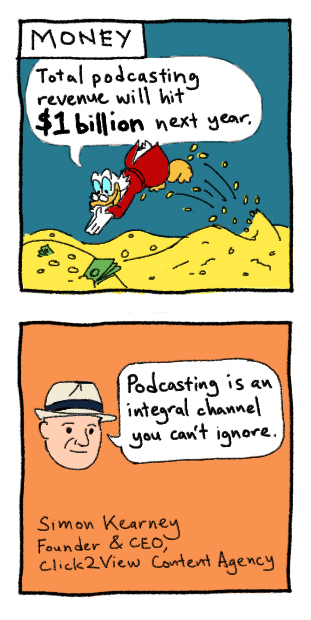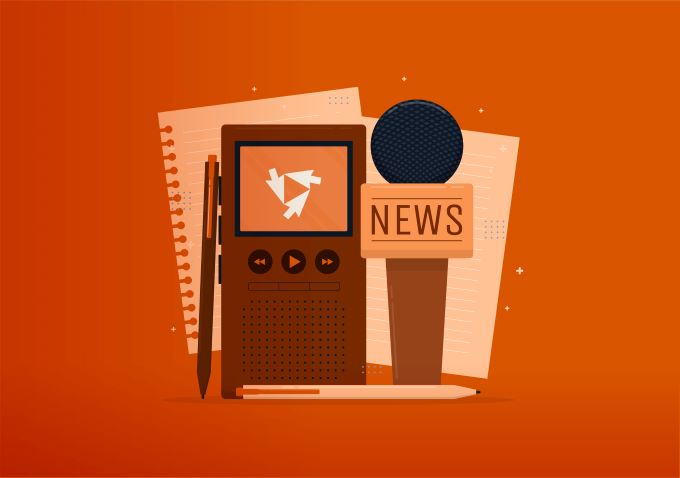

Podcast is growing


From small talk to mass market, podcasting is becoming mainstream
People have been calling podcasting the next big thing for years. We can finally say they’re right. More than half of Americans have now listened to a podcast and about 1 in 4 are tuning in weekly.
Let’s put these numbers in context. A single show by popular podcaster Joe Rogan will be heard by about 10 million people. CNN’s star anchor Anderson Cooper is lucky if he gets 3 million.
Number of employees at CNN: 3,000.
Number of employees with Joe Rogan: a guy named Jamie.
The US isn’t even the most popular place for podcasting. Thanks in part to better data collection we now know that 58% of South Koreans are listening to podcasts monthly. It’s 55% in Hong Kong and 47% in Taiwan.
South Koreans initially fell in love with a podcast sensation called Naneun Ggomsuda (I’m a Sneaky Trickster), a satire developed by four comedians to tap into widespread disgust with politics. But it helped that South Korea leads the world in early adoption of technology from smartphones to mobile networks where, last year, they were the first country to introduce 5G.
This brings us to the first reason why the age of podcasting has finally arrived.

Reason #1: Technology
Mobile networks that provide speedy downloads of data, and the phones that let us use that data, have freed us from sitting in front of the TV and Anderson Cooper. Meanwhile, EarPods, AirPods, HomePods and hundreds of other devices are populating this new audio ecosystem, further expanding the reach and convenience of podcasting.
How convenient? More than half of listeners are doing housework, cooking or driving, while 43% are at the gym and 37% are squeezing in a podcast at work.
As these smart devices and fast mobile networks spread to more countries, podcasting follows. Just half of people in India use the Internet but 40 million are already listening to podcasts. How hungry are Indian consumers for mobile content?
They downloaded the TikTok app 323 million times in 2019, over 40% of the app’s global total. TikTok and podcasting are both piggybacking on new tech but they have something else in common too.

Reason #2: Authenticity
Meet Lex Fridman. He’s an amazing AI scientist. But his voice is such a plodding, robotic monotone that it should be prescribed to help people fall asleep. I’m not being mean. That’s how he describes himself. So why is his podcast getting millions of downloads?
Because his interviews with innovators like Elon Musk are unhurried, respectful and fuelled by a sense of wonder and curiosity shared by his audience. No flashy sets, drama and ego. Just a deeply authentic experience involving Lex, his guest and the listener.
In a noisy digital world clamouring for our attention, it turns out that people are still hard-wired for a personal connection. This translates into a high level of trust and engagement with podcasters. And their ads as well. According to Business Insider, 55% of podcast listeners say they pay attention to ads, 10% more than those following radio ads and much higher than the 34% who pay attention to online video ads.
Consumers like authenticity. They like lots of choices too.

Reason #3: The Long Tail
Did you know that McDonald’s used to sell pizza? If you heard this fact from a friend over a Big Mac, you might find it mildly interesting and then forget it by the time you polished off your fries. However, there are people out there who find this so interesting that a series called Whatever Happened to Pizza at McDonald’s is going strong after more than 150 episodes.
Welcome to the Long Tail of podcasting, the unique corner of the media universe where our supposedly shrinking attention spans can sustain a weird series about pizza for years.
The Long Tail was coined by former Wired editor Chris Anderson to refer to the digital age’s ability to provide an endless number of products for an endless number of interests. A traditional bookstore can stock hundreds, maybe thousands, of titles before running out of space. But Amazon’s Kindle reader reportedly has over six million.
This ubiquity of cheap and plentiful information applies to podcasting too, with over 900,000 podcast shows and 30 million episodes drawing in people who can’t find their interests represented in traditional media.
Headwinds
These are impressive numbers but not all is rosy in the podverse. In China, the audio platform Ximalaya had attracted almost 100 million users when it ran into government censors. Twenty six podcasts were shut down for engaging in things like “historical nihilism,” which refers to history at odds with the official narrative and often involves topics like ghosts, zombies and marriages between the dead. Ximalaya’s app was removed from Android platforms for 30 days last July.
Another concern is monetisation. Despite rapid growth, ad revenue for podcasts was just S$917 million last year compared with $$25 billion for radio and almost $$95 billion for TV.
Podcasters and marketers are still trying to figure out the best way to leverage the high engagement they have with users without alienating them with yet more digital noise. Recent developments suggest they may be succeeding, and for that reason monetisation is also a reason to be optimistic about the potential of podcasting.

Reason #4: Money, money, money
Podcasts are monetising ad revenue at only one cent per hour versus 11 cents for radio and 13 cents for TV. That’s surprising if you consider the growing number of listeners and their very high trust and levels of engagement.
But this won’t last long. Big companies are noticing. The digital music provider Spotify bought yet another podcast company last month, adding to the more than $400 million it has spent snapping up podcasters. Talent is moving as well. Just last week, Huffpost’s top editor, Lydia Polgreen, jumped ship for podcaster Gimlet Media. Oprah has made an appearance too. She’s started turning her old shows into podcasts and they’ve been an instant hit.
And of course no place senses opportunities like Silicon Valley so a small army of startups like Podcorn are entering the fray, using algorithms to match podcasters with advertisers.
All this activity is translating into a lot of money. PWC estimates total podcasting revenue will jump to $1 billion next year. That’s up over 50% from last year when (sorry, Anderson Cooper) television ad revenue declined globally.
Read more from Click2View:
- Amidst the disruption from COVID-19, use LinkedIn Live for your content marketing.
- Had an event planned? Here’s 5 things you can do to salvage it.
- Expectations versus budget. How can you juggle?
Sign up to our newsletter for more.
Click2View is Southeast Asia’s premiere full-service independent B2B content marketing agency servicing clients like Microsoft, Google, Visa, Prudential, and the Lee Kuan Yew School of Public Policy.








